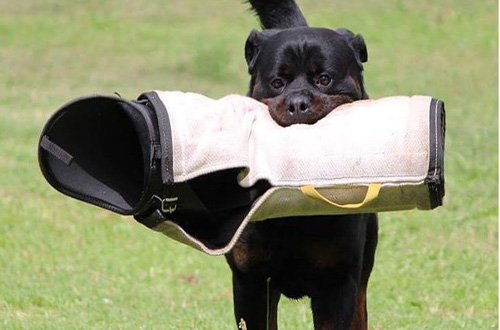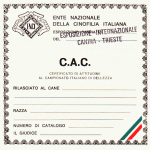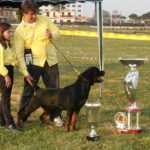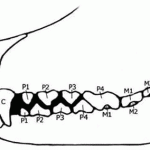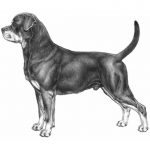The purpose of the ZTP is to ensure the use in breeding of subjects possessing the morphological and character skills required by the standard, or, to exclude unsuitable individuals.
Before being able to be entered and judged in a test of ZTP, each subject must:
- be enrolled in the Books of Origin E.N.C.I..;
- having accomplished at least 18 months on the day of the test;
- having been subjected to official radiographic assessment for hip and elbow dysplasia by a recognized veterinarian.
The original pedigree and documentation of hip dysplasia must be attached to the registration (maximum permissible grade hd-c) and elbow (highest degree admitted ed-2); also the owner must be Rottweiler Club member. To a possible representation of an already rejected dog, the judgment of the previous ZTP must also be attached.
PRESENTATION
All dogs must be presented in a way that they do not disturb others and are not disturbed themselves. No other dogs are allowed in or out of the ring.
CONDUCT OF THE TEST
All males must be judged first and then all females.
Subjects are evaluated:
- appearance, body size, meaning, gait, teeth, fur, etc.;
- indifference to the shot (minimum caliber blank pistol 6) , indifference to the people in the group;
- character-instinct test.
The judge will entertain the conductor for a few minutes before the rehearsal to explain the meaning of the rehearsal, the reason and meaning of the exercises designed to evaluate the character and instinct of the dog.
The judge will review the subject when stationary and in motion thereby acquiring confidence with the dog.
An interview with the owner about the behavior, l’breeding and environmental influences will complete the picture.
Later the judge will measure the subject e will check the dentition, will evaluate your eye color with the table (colorimeter):
- rottweiler with color dal 1a al 4a will be admitted to the continuation of the test;
- rottweiler with dal color eyes 4b al 5 e 6 they will not be able to continue the test.
In a quiet place the is judged dog reaction to the “shot” It is in the “group”:
The handler goes to a point on the pitch, with the dog on a leash where there will be a group of people.
A 10/15 steps away between the dog and the group the judge will give the order fire two shots with a minimum interval of five seconds between the first and the second. E’ faculty of the judge, if the dog showed reactions, order a third or fourth shot to be fired while the subject is on a leash or seated and off the leash; if the dog shows further reactions, he will not be able to continue the test.
The dog he will then enter the group of people proving casual even when he has to take the sitting position and the people in the group will huddle around him. Just this test "different from others" tends to demonstrate the safety of the dog and its trust in the handler.
Immediately after, the defense test, the intensity of the attack will be equal to that of an IPO1 or Sch H1.
The dog should wear a fixed, unrestricted chain collar (only one ring is allowed, obviously not the one for the strangling).
The handler with the dog on a leash will go to the hiding place behind which the helper placed at approx 40 steps away.
After about 20 steps the dog will be left without the leash and the remaining distance can be covered either with the dog free or conducted by the collar. However, the dog must remain next to its handler until the moment of the attack when the helper comes out of hiding and runs against the handler threatening him, only then should the subject be left free to attack. All this will happen only on the order of the judge.
The dog will have to immediately grab the grip and bite; in this moment of the test he will receive two blows from the helper with the leather staff. Hits are allowed on the thighs, the lateral parts of the trunk and on the withers. The conductor's vocal exhortation is allowed.
By order of the judge, the helper will stop the attack and the subject will be ordered to “leaves”.
To pass the test the Rottweiler must perform at least one “leaves” without the manual intervention of the conductor. After finishing the attack, the dog must absolutely remain with the helper in “vigilance”.
Calls or aids of any other kind are prohibited, to force the dog to stay with the helper, both for this test and for the next one (test of courage).
After the sudden attack, the handler will hold the dog firmly by the collar.
The helper will begin to flee, paths approx 50 steps, by order of the judge, the handler will have to throw the dog for the attack. The handler is allowed to follow the dog for a few steps, but he must stop at the command of the judge. The judge will ask the helper to turn around, when the dog is about 20 steps. The helper will turn and run in the direction of the dog threatening him. The Rottweiler will reach the helper without hesitation and will attack as quickly as possible. The dog, in this phase of the attack, it will not receive any hits. By order of the judge, the helper will stop the attack.
The subject will be ordered on “leaves” and will have to stay in “vigilance” at the helperwithout any help from the handler to whom the judge will ask, then, to get close to his dog quickly.
Those subjects who do not bite or who at the end of the exercise will leave the helper ahead of time will not pass the test. The owner of the dog is responsible for any damage caused.
The dog that abandons the helper after or before the order leaves and returns to the handler, can't get the ZTP.
JUDGE'S REPORT
The judge may postpone a subject's trial from 2 a 6 months if he found developmental anomalies or lack of some character skills. At the end of this deadline the dog can be re-presented. Subjects who are postponed can repeat the test twice; if the outcome is negative, will not be recommended for reproduction.
Should not be judged that subject who presented the closure of the pincer teeth; this subject can be resubmitted only after completion, minimum, gods 30 months of age. The ZTP is confirmed if the dentition has not changed.
For individuals aged between 18 ed i 36 months, when at the morphological examination of the judge the dental occlusion of the dog shows up with the upper incisors group that covers the lower incisor group for less than one third in occlusion, the subject must be reviewed after the completion of the 36 months of age. Furthermore, the judge has the right to declare revisable later 3 O 6 months the subject who on the morphological examination was affected by a physical anomaly such as to require the opinion of a commission of experts external to the jury of the ZTP itself.
Related Posts
NEWS MOST 'INTERESTING
on our blog all the most interesting news about the world of dog world. If you are interested in some information about expo, dog health, breeding Dell'Antico Warrior, you can not find. Contact us we shall be glad to publish some post about it.


